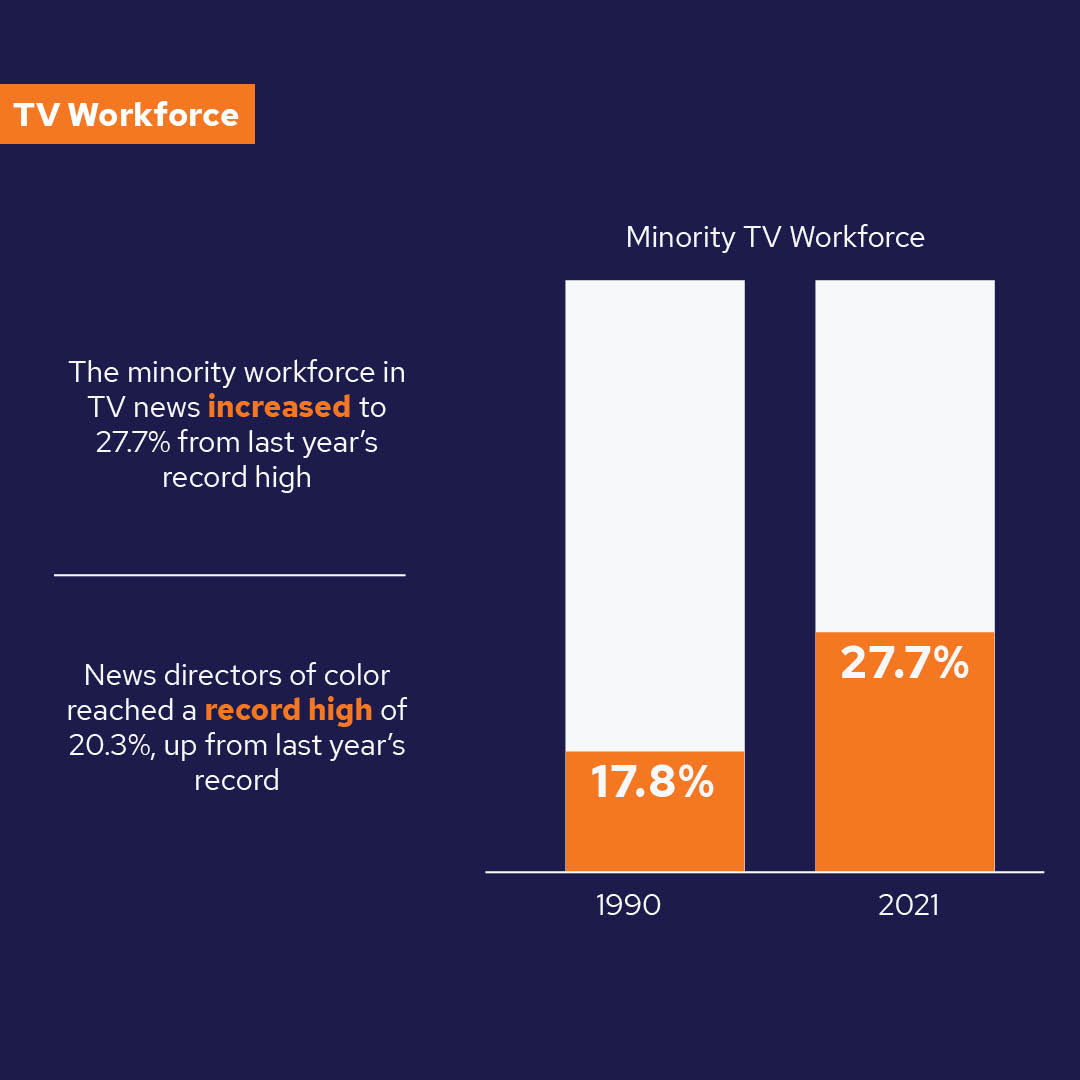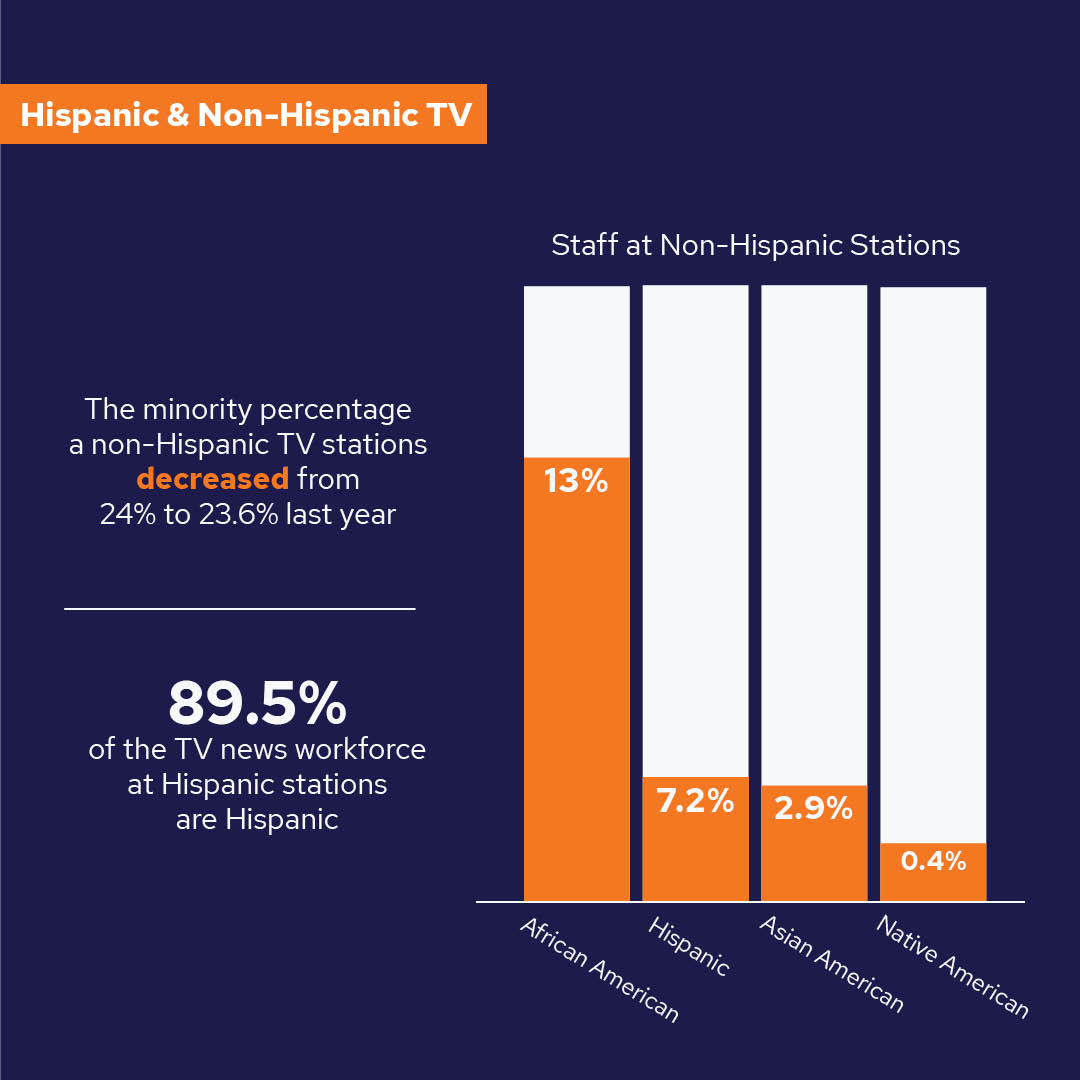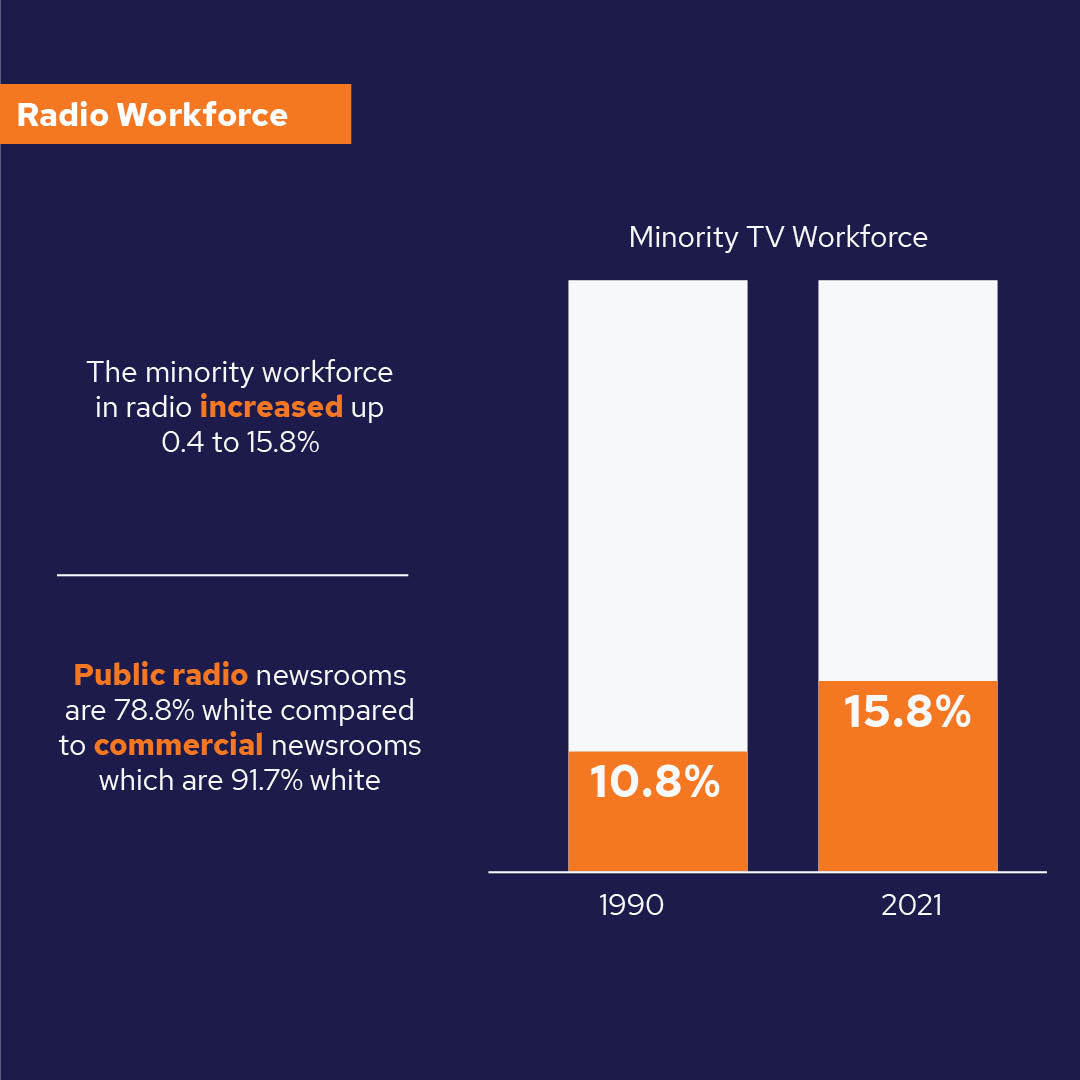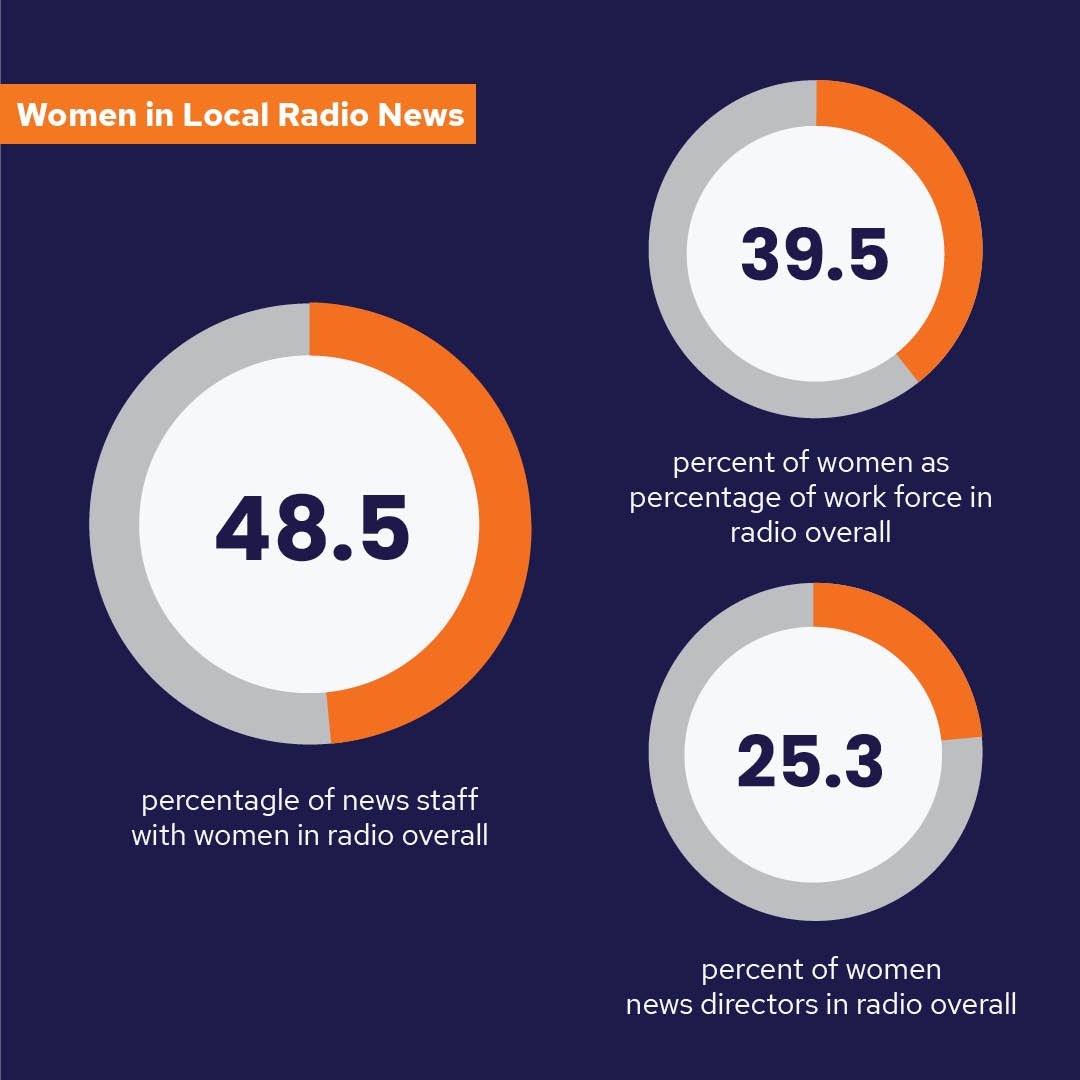Local News Diversity Reaches Records, But Representation Gap Shrinks Slowly

TV
People of Color in Local TV News
 For the fifth year in a row, representation of people of color in local TV news improved overall and, for the fourth year in a row, a record high percentage of the local TV news workforce are people of color.
For the fifth year in a row, representation of people of color in local TV news improved overall and, for the fourth year in a row, a record high percentage of the local TV news workforce are people of color.
People of color make up 27.7% of the local TV news workforce, up 1.1 percentage points from last year’s record high.
Hispanic/Latino and Asian American representation improved by 1.3 and 0.8 percentage points respectively. African American representation, after seeing the biggest gains last year, dipped by one percentage point. Native American representation remained level.
While the gap in representation between the overall U.S. population and the local TV workforce has been slowly but steadily shrinking over the last six or more years, TV news is less diverse by 12.2 percentage points.
According to the Bureau of Labor Statistics, the U.S. workforce is 17% Hispanic, 13% African American, 6% Asian American, 1% Native American. In local TV, the workforce is 12.2% Hispanic/Latino, 12.3% African American, 2.8% Asian American and 0.4% Native American.
Representation by Station Type
Stations in the top 25 markets are most representative, but smaller market and smaller staff size stations have become more even.
Independent stations are much more representative than network affiliates, which became slightly less representative over the last year.
Geographically, stations in the Midwest lag in racial and ethnic diversity, followed by the Northeast, with stations in the South and West most representative.
 When excluding Spanish-language stations, 23.6% of TV news employees are people of color, just off last year’s record high. Asian Americans were the only group to see gains at non-Spanish language stations in the last year.
When excluding Spanish-language stations, 23.6% of TV news employees are people of color, just off last year’s record high. Asian Americans were the only group to see gains at non-Spanish language stations in the last year.
News staff at Spanish-language stations are 89.5% Hispanic/Latino, down from 98.9% last year. The balance of staff at Spanish-language stations is 8.1% white, 1.7% African American and 0.8% Asian American.
Women of Color
Of people of color, women are better represented among Hispanic/Latino Americans, African Americans and Asian Americans. Native Americans in TV news are predominantly men.
People of Color in TV News Management
News Directors
This year’s survey recorded the most news directors of color ever, beating last year’s record high by about three percentage points. Five of the six best years for representation among news directors have been in the last six years, but still just one in five news directors are people of color. That’s more than seven percentage points behind representation among the total local TV workforce, and nearly 20 percentage points behind the overall U.S. workforce.
This year saw all-time highs for African American news directors (6.5%) and Hispanic/Latino (10.3%) news directors. However, excluding Spanish-language stations, Hispanic news directors lost ground. At non-Spanish language stations, 15.6% of news directors are people of color, beating 2018’s high.
Independent, non-network affiliated stations are significantly more representative, with 65.5% of independent stations having people of color news directors compared to 14.1% at network affiliate stations. Among major network affiliates, ABC and CBS have the most representative newsroom leadership, but unlike Fox and NBC affiliates, a few of their affiliate stations still have no people of color on staff.
Stations in the top 25 markets have the most diverse news directors, with the biggest stations of 51+ staff lagging. Geographically, the Midwest and Northeast lag in representation among news directors as well as overall.
General Managers
The percentage of general managers who are people of color increased almost 3 percentage points to 9.8%, or 5.9% when excluding more diverse Spanish-language stations. In fact, this year’s gains were exclusively attributed to Spanish-language stations, since general manager diversity actually decreased slightly at all other stations. The overall increase recovers about half of the ground lost last year, but leaves representation among general managers worse than 2019’s highs.
Women in TV News
 For the first time in more than 25 years of the annual survey, all local TV newsroom respondents have women on the news team. In past years, a few stations with smaller staffs or in smaller markets did not have any women.
For the first time in more than 25 years of the annual survey, all local TV newsroom respondents have women on the news team. In past years, a few stations with smaller staffs or in smaller markets did not have any women.
However, women’s representation in the TV news workforce fell slightly overall from 44.7% of newsroom staffers to 43.9%, reflecting a broad and troubling trend of COVID’s impacts forcing women out of the workforce.
Pre-COVID, women made up 47% of the U.S. full-time workforce, or, according to the Department of Education, 57% of college graduates and 53.5% of the college-educated workforce, so representation in newsrooms continues to lag.
Women in TV News Management
For the sixth year in a row, there is a new record high percentage of TV news directors who are women – nearly 40%. The percentage of women news directors increased by 2.3 percentage points.
Women TV news directors are most common in the top 50 markets, where half of news directors are women. Public TV stations are also more likely than commercial stations to have news directors who are women.
Among TV news general managers, 90% are white and 77% are men. Women general managers did regain most of last year’s losses, now making up 22.8% of GMs, up 3.8 percentage points.
Radio
People of Color in Radio News
 Radio newsrooms now include the highest percentage of people of color in radio since 1998 – and the second highest percentage ever – but nearly 85% of the radio news workforce is still white. The local radio news workforce is 15.8% Black, Indigenous or people of color overall, up just under half a percent.
Radio newsrooms now include the highest percentage of people of color in radio since 1998 – and the second highest percentage ever – but nearly 85% of the radio news workforce is still white. The local radio news workforce is 15.8% Black, Indigenous or people of color overall, up just under half a percent.
Public radio is significantly more representative, for both women and people of color, than commercial radio news. Public radio newsrooms are 78.8% white compared to commercial newsrooms which are 91.7% white.
Representation in radio news improved over the last year for news staff identifying as Native American or Hispanic/Latino, but slipped slightly for African American and Asian American radio staff.
People of Color in Radio News Management
Representation of people of color increased marginally among radio news directors, from 7.1% to 7.2%. This year saw higher percentages of radio news directors who are African American or Hispanic/Latino, but fewer who are Native American.
Local radio general managers of color made up most of the ground lost last year, but 93% are still white. General managers of color are more than twice as frequently found in major markets.
Stations in the Midwest had the least diverse management, with stations in the South and public stations more representative among radio management.
Women in Radio News
 Fewer than half of radio news staffs include any women at all, up slightly from last year, especially smallest markets. Overall, women are just under 40% of the radio workforce, down slightly in the last year. Men outnumber women in radio 60.5% to 39.5% overall, as well as among white, Hispanic/Latino and Native American radio staffers. Among African Americans and Asian Americans in radio news, women outnumber men.
Fewer than half of radio news staffs include any women at all, up slightly from last year, especially smallest markets. Overall, women are just under 40% of the radio workforce, down slightly in the last year. Men outnumber women in radio 60.5% to 39.5% overall, as well as among white, Hispanic/Latino and Native American radio staffers. Among African Americans and Asian Americans in radio news, women outnumber men.
Women in Radio News Management
There are fewer women radio news directors this year, down 3.5 percentage points from close to a third to just over a quarter. The public-commercial gap in representation grew, with women better represented than last year at public stations, but worse at commercial ones. Public radio women news directors now outpace commercial women radio news directors by 18 points.
Radio general managers are slightly more representative this year, with women making up almost 3 percentage points more than last year, but still 73.3% of GMs are men.
Note that the typical (median) radio news operation had a full-time news staff of one, with the overall average number of full-time staffers at just over 3.
Major markets are those with 1 million or more listeners. Large markets are from 250,000 to 1 million. Medium markets are 50,000 to 250,000. Small markets are fewer than 50,000.
Bob Papper is Adjunct Professor of Broadcast and Digital Journalism at Syracuse University and has worked extensively in radio and TV news.
About the Survey
The RTDNA/Newhouse School at Syracuse University Survey was conducted in the fourth quarter of 2021 among all 1,780 operating, non-satellite television stations and a random sample of 3,379 radio stations. Valid responses came from as many as 1,336 television stations (75.1%) and 765 radio news directors and general managers representing 2,310 radio stations. Some data sets (e.g. the number of TV stations originating local news, getting it from others and women TV news directors) are based on a complete census and are not projected from a smaller sample.
Graphics credits: Chandler Claire Dewgard / Syracuse University
